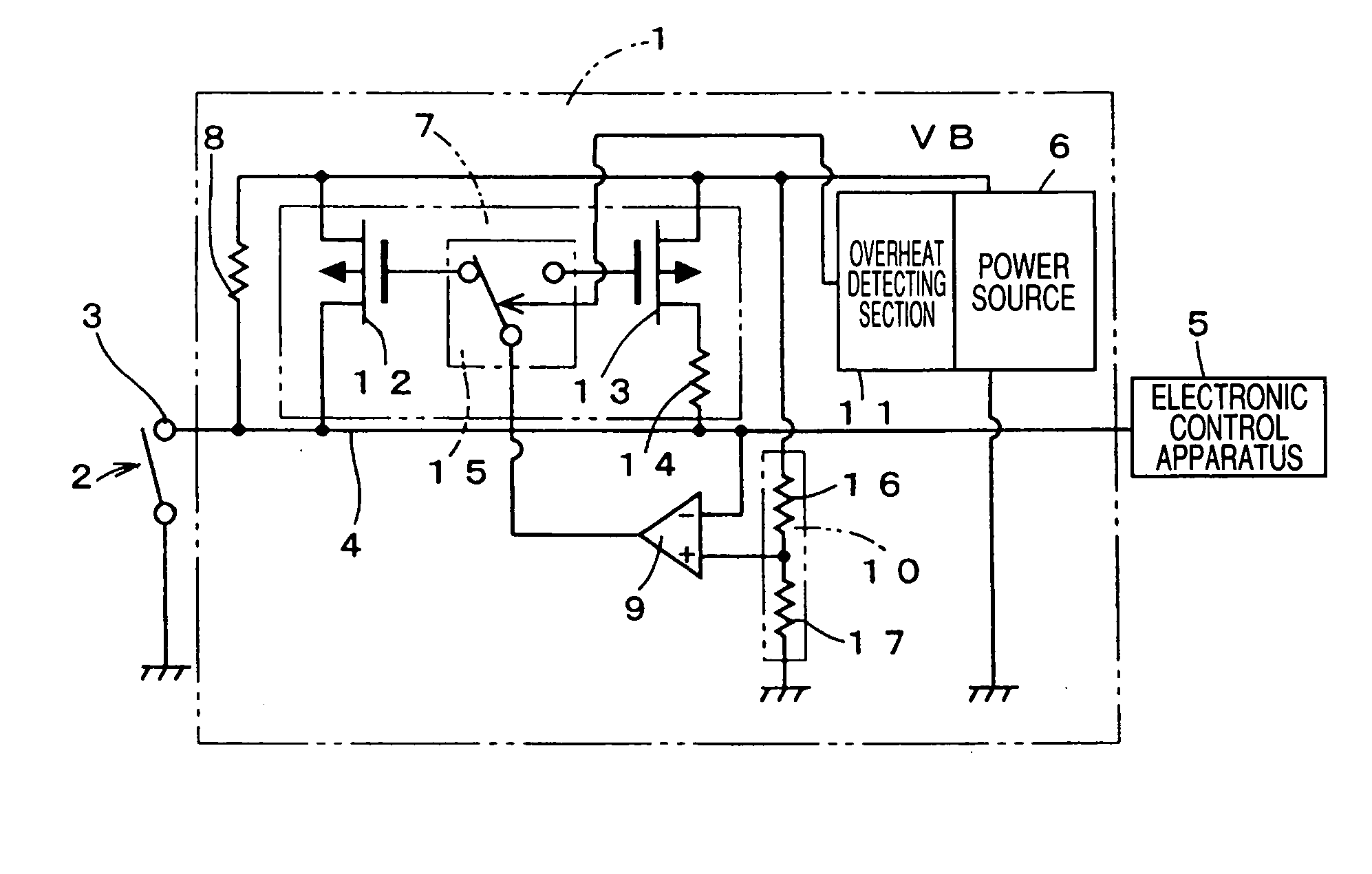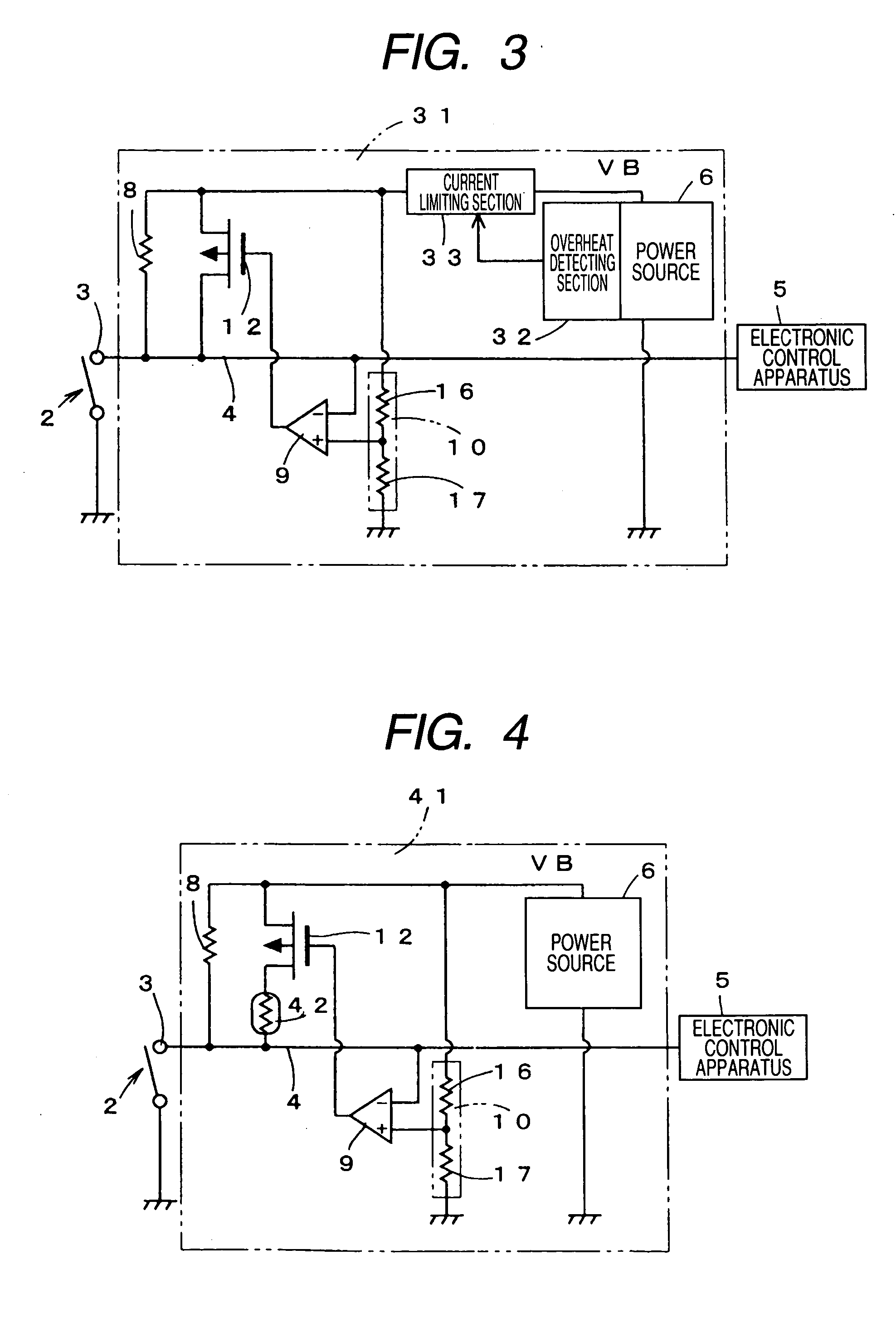Apparatus for preventing corrosion of contact
a technology of a contact and an apparatus, applied in the direction of contacts, percussive tools, manufacturing tools, etc., can solve the problems of increasing power consumption or generating noise, increasing loss in lsi, and current generating heat, so as to achieve the effect of easy noose judgment on the conta
- Summary
- Abstract
- Description
- Claims
- Application Information
AI Technical Summary
Benefits of technology
Problems solved by technology
Method used
Image
Examples
first embodiment
[0032]FIG. 1 illustrates a schematic electrical configuration of a apparatus 1 for preventing corrosion of a contact, according to the invention. The apparatus 1 has a function of preventing corrosion of a contact 3 of a switch 2. The contact 3 is connected via an input signal line 4 to an input side of the electronic control apparatus 5 at a subsequent stage. The contact 3 may be a contact of a connector. The apparatus 1 may be realized as a part of an LSI. A power source 6 generates a power-supply voltage for operating a logic circuit, from power supplied outside the LSI, and supplies it to inside of the LSI. The power-supply voltage for operating the logic circuit is, for example, 5V or 3.3V. This power source 6 is grounded at a low side thereof and outputs the power-source voltage from a high side thereof. The contact 3 is different in number and structure, depending on types and structures of the switch 2 or a connector. Moreover, the contact resistance of the contact 3 is an e...
third embodiment
[0041]FIG. 3 illustrates a schematic electrical configuration of an apparatus 31 for preventing corrosion of a contact, in accordance with the invention. The contact apparatus 31 has an overheat detecting section 32 for detecting an overheat state of the power source 6, similar to the overheat detecting section 11 as shown in FIGS. 1 and 2. The apparatus 31 also has a current limiting section 33. The overheat detecting section 32 controls the current limiting section 33 disposed in a channel through which a current is supplied from the power source 6 to the switching element 12 serving as a low impedance section. The current limiting section 33 is implemented by a MOS transistor or a bipolar transistor. When the overheat state is not detected, the current limiting section 33 becomes a low impedance to reduce a limiting amount with respect to the current supply. On the other hand, when the overheat state is detected, the current limiting section 33 becomes a high impedance to limit t...
fourth embodiment
[0044]FIG. 4 illustrates a schematic electrical configuration of an apparatus 41 for preventing corrosion of a contact, in accordance with the invention. In the apparatus 41, a positive temperature characteristics resistance element 42 is connected in series to the switching element 12 serving as a low impedance section. Although the positive temperature characteristics resistance element 42 is disposed on the drain side of the P channel MOS transistor, which is the switching element 12, the positive temperature characteristic resistance element 42 may be disposed on the source side thereof or disposed at a position of the current limiting section 33 shown in FIG. 3.
[0045] The positive temperature characteristics resistance element 42 has positive temperature characteristics, which increase in resistance value according to elevation of temperature. In general, electric conductive materials such as a metal increase in resistance value according to elevation of temperature. For exampl...
PUM
 Login to View More
Login to View More Abstract
Description
Claims
Application Information
 Login to View More
Login to View More - R&D
- Intellectual Property
- Life Sciences
- Materials
- Tech Scout
- Unparalleled Data Quality
- Higher Quality Content
- 60% Fewer Hallucinations
Browse by: Latest US Patents, China's latest patents, Technical Efficacy Thesaurus, Application Domain, Technology Topic, Popular Technical Reports.
© 2025 PatSnap. All rights reserved.Legal|Privacy policy|Modern Slavery Act Transparency Statement|Sitemap|About US| Contact US: help@patsnap.com



